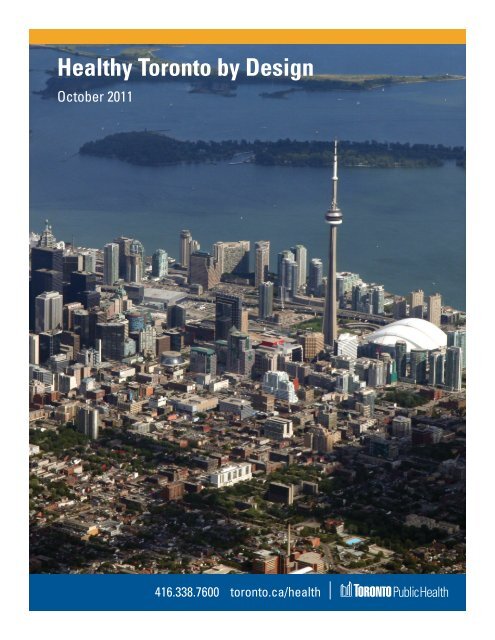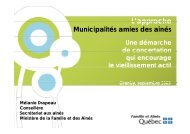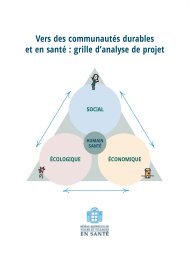Download It
Download It
Download It
- No tags were found...
You also want an ePaper? Increase the reach of your titles
YUMPU automatically turns print PDFs into web optimized ePapers that Google loves.
Qualities of Great CitiesFactors that make a city healthy also make a city liveable for residentsand good for business 3 – cities where people like to live are cities thatprovide businesses with more customers and potential employees.Several organizations rank cities with respect to their quality of life orenvironment for business. While the results of each of these are differentbecause of the difference in the methods used, they include commonfactors that are considered important when assessing a great city (see boxbelow).First there is employment. Most people depend on employment to earnan income. Cities that have high employment are considered moredesirable places to live. 4 Also important is the quality of those jobs –cities with a higher proportion of people in high quality jobs are morelikely to be ranked high because people have more disposable incomewhich has a ripple effect on the economy and contribute to higheremployment in the area.Education is another important factor. Cities with good schools anduniversities are more desirable as places to work and to do business.Parents want the best education for their children. The presence ofuniversities and colleges means that there is a pool of highly educatedworkers in the community, which attracts business who benefit from amore productive workforce. 5Cities with affordable housing are considered better places to livebecause people can find a residence of good quality and still havesufficient resources to cover food, education, recreation and other needs. 6Mixed-use neighbourhoods also contribute to the quality of life –housing that is close to schools and commercial areas with retail andother services makes life more convenient and reduces travel distances. 7A good transportation system makes it easier for people and goods to getto their destination in less time. This means that people can spend lesstime commuting to work or travelling to other places in the city. 8 <strong>It</strong> alsomeans that goods can be transported more efficiently, which lowers thecost of doing business. Given the size and density of cities, public transitWhat Makes a Great City? Access to health care Affordable housing Clean environment Employment opportunities Food security Good governance Good transportation system Quality education Recreational opportunities Safety Sanitation Social inclusion Vibrant cultureHealthy Toronto by Design | Toronto Public Health, October 20112
is a core component of an urban transportation system. More and more,infrastructure for non-motorized transport and walking is considered afeature of a good place to live. Transportation infrastructure that meetsthe needs of people with lower mobility (such as children, seniors andpeople with disabilities) makes a community more accessible to all. 9People value a quality environment. Homes on streets with trees or nearparks have a higher market value than comparable homes in other areasof a community. Clean air, green space and natural areas are features thatpeople want in their community. Urban green spaces have a number ofenvironmental benefits such as protecting biological diversity, regulationof urban climate, pollution control, and nature conservation. 10 At thesame time, they offer space for social interaction, recreation, and play.The availability of recreation facilities – trails, sports fields, playgrounds,gyms, rinks, swimming pools – makes a community more attractive. Agreat city includes special places to visit, public spaces and buildings,special events and cultural facilities such as libraries cinemas, theatres,museums, and art galleries enrich the day-to-day life of people. 11People want to feel safe where they live. 13 A safe city with a low crimerate and good pedestrian and road safety is more liveable. Access tohealth care and the availability of clean drinking water, good sewagetreatment and waste management systems are additional features that areimportant for a city to have.Good governance is transparent, accountable, effective, efficient, andfollows the rule of law. 14 This contributes to a good business climate. <strong>It</strong>is also participatory and inclusive, engaging the public in the decisionmakingprocess to build consensus and foster equity. This results in allresidents having a stake in the community and the future of the city."the state of our citiesdetermines Canada's socialand economic health." 12- Charles Coffey, formerExecutive Vice-President RBCFinancial GroupLike governance, social inclusion is made up of many different aspects.In a city that is inclusive everybody feels they belong. <strong>It</strong> provides for astrong sense of pride in the city and helps people feel engaged with thecommunity around them. <strong>It</strong> also means that a city makes the best use ofthe available human capital. Inclusion is fostered when there is lessdisparity in income, less discrimination and more participation insociety. 15Toronto’s RankingsThere are many different quality-of-living surveys. Toronto often ranksamong the best cities. 16 However, maintaining these top rankingsrequires the City to continually invest in remaining an attractive place tolive and do business in. The Toronto Board of Trade Scorecard onProsperity compares 25 global cities. 17 In 2011, Toronto ranked 8 th ,down from 4 th in 2010 and 2009. 18,19Toronto ranked high on various economic indicators such as level ofprofessional employment, overall tax burden and the number ofHealthy Toronto by Design | Toronto Public Health, October 20113
esidential permits issued, which is a sign of confidence in the economy.On indicators of labour attractiveness, which relate to quality of life,Toronto ranked high for its large proportion of immigrants, good teacherstudentratio in schools, population with higher education, and arelatively low crime rate. Toronto rated reasonably well for housingaffordability because of the high cost of living in other major cities in theworld. However, it was the second least affordable Canadian city withVancouver being the least affordable.These findings point to areas of strength that Toronto needs to maintainin the future. Toronto did poorly on other indicators. On the economicside, the Board of Trade continues to express concern about productivityand innovation. As well, the Toronto region ranked at the bottom withthe longest commute times of the 25 cities assessed, which reduced itsoverall labour attractiveness. The Scorecard also notes that Toronto’sGini coefficient (a measure of equality) is the lowest among Canadianmetropolitan areas.Healthy Toronto by Design | Toronto Public Health, October 20114
Cities and HealthThe recognition of the impacts of cities on health has a long history.Modern-day public health has been traced back to Edwin Chadwick,secretary to the Health in Towns Commission established by the Britishgovernment in 1843. 20 Since healthy workers were needed, theCommission looked at how to improve the health of the working poorwho had flocked to rapidly industrializing cities. This led to theestablishment of public health measures such as health regulations,housing standards, safe drinking water supplies and creation of sewersystems. These interventions had a dramatic effect on public health inBritain in a very short time.In 1909 Canada established the Commission on Conservation. 21 <strong>It</strong>sPublic Health Committee identified good town planning as integral to thepreservation of the environment and people's health. Thomas Adams,advisor to the Committee from 1914-1919 was instrumental in thedevelopment of town planning legislation across the country.Toronto was one of the first cities in the world to begin chlorination ofdrinking water in 1910, which by 1915 was followed with chlorination ofsewage and water filtration. 22 In July 1915, Maclean's magazine declaredToronto the healthiest of large cities in the world. 23 This high level ofpublic health was achieved due to the leadership of Dr. Charles Hastings,Toronto's Medical Officer of Health, the political commitment of citycouncil, and support of the community. Under the tenure of Dr. Hastings,the work of the public health department addressed health in theworkplace, social welfare, housing, school health, community healtheducation, diet and nutrition, child rearing, and care for the sick. 24 Thesepublic health interventions and those that followed, such as universalimmunization and food safety programs, have greatly reduced the burdenof illness from communicable diseases and helped make Toronto the cityit is today.Good city buildinghelped reducecommunicable diseasesIn the past several decades, the risks to health have been changing.Chronic diseases are now the leading cause of death and disability inCanada. These diseases include respiratory ailments, coronary heartdisease; non-insulin dependent diabetes (Type II), overweight andobesity, high blood pressure and stroke, osteoporosis, cancers, stress anddepression. There is substantial evidence that these diseases as well astheir risks are not distributed evenly across the population. In the 2008report The Unequal City, Toronto Public Health demonstrated that areasof Toronto that have a greater proportion of people living with lowincome experience more risk factors for illness (for example, physicalinactivity, overweight/obesity, smoking), higher rates of disease anddeath at an earlier age compared with higher income areas. 25Healthy Toronto by Design | Toronto Public Health, October 20115
<strong>It</strong> is well-recognized that the conditions in which people live, work, learnand play shape health and that inequity in these conditions are largelyresponsible for producing health inequities. 26 Urban health inequities arenot just harmful to those who are most vulnerable 27,28 – there are alsosubstantial social and economic costs associated with them. 29 This meansthat the way cities are built and how well they perform on these factorsare critical not only for the health of residents but also for the social andeconomic well-being of cities. 30 The sections that follow highlightfeatures of the physical and social environment of cities and theirrelationship to health.Natural EnvironmentFactors in the natural environment such as air and water quality,sanitation, waste and green space are important contributors to health.Healthy cities have good air,soil and water qualityThe importance of water and sanitation for good health has been knownfor many years. Contaminated drinking water, improper wastewatertreatment and poor sanitation can cause illness through water-borne andmicrobial diseases such as cholera and typhoid. 31,32 These diseases canspread particularly quickly in crowded populations. Events such asWalkerton, Ontario in 2000 are a reminder the importance of effectivewater treatment to protect health. 33The management of solid waste and wastewater is important forprotecting the health of cities. 34 Homes and businesses producehazardous waste that can present a risk to people and the ecosystem ifimproperly stored or handled. Waste, such as used oil, batteries, fuel,pesticides and cleaning products can be explosive, corrosive, flammableand/or poisonous. Discarded electronics and fluorescent lights cancontain heavy metals, and syringes and needles can transmit disease andpresent a physical hazard. Health risks can arise from direct exposurethrough accidents or handling by residents and waste management staff,or through the release of these substances to air and water during storage,transport or leakage at waste facilities. 35Transportation, burning of fossil fuels for heating and pollution comingfrom elsewhere contribute to the mix of air pollutants in the city. Theadverse health impacts of air pollutants commonly found in cities arewell known. In 2008 the Canadian Medical Association estimated that21,000 Canadians die from the effects of air pollution each year – mostlyin Ontario and Quebec – and predicted that premature deaths associatedwith chronic exposure to air pollution could to rise 83 percent between2008 and 2031. 36Parks, gardens and other public green spaces play an important role inthe health of our city and our residents. These areas provide opportunitiesfor exercise, physical activity and relaxation. There is evidence thatcontact with nature is associated with health benefits such as lower bloodpressure and cholesterol levels, enhanced survival after a heart attack,more rapid recovery from surgery, fewer minor medical complaints andHealthy Toronto by Design | Toronto Public Health, October 20116
lower self-reported stress. In children with attention disorders and inteens with behavioural disorders, contact with nature has resulted insignificant improvement. 37 Living near green space has also been foundto benefit mental health. 38,39Parks also build healthy communities by contributing to stableneighbourhoods and strengthening community development. Researchshows that residents of neighbourhoods with greenery in common spacesenjoy stronger social ties. 40 Increasingly, parks are also being used forcommunity gardens which provide residents with healthy, affordablefood and opportunities for physical activity and socialization. As anecosystem, green space – particularly trees, but also grass, perennials,shrubs and other vegetation – also provide benefits to health byimproving air and water quality and mitigating the health impacts ofGreen spaces have health,social, ecological andeconomic benefits to citiesCreating Healthy EnvironmentsTackling Climate Change Vancouver's Green Capital Plan and Toronto's Clean Air,Climate Change and Sustainable Energy Action Plan areexamples of municipal strategies that outline localinvestments to address climate change and stimulatesustainable business and community transformations.Programs to Increase Urban Forests The Urban Forest Management Strategy of Regina,Saskatchewan, aims to maintain Regina's urban forestthrough policies and regulations such as plant diversitygoals, procedures for plantings and removals on public andprivate property, tree donation programs and heritage treedesignation. Town of Oakville Urban Forest Strategic Management Plansets out a 20-year (2008-2026) plan to protect and enhanceits forest canopy on public and private land. The plan isinformed by an extensive audit of tree populations, thehealth benefits of the urban forest and factors influencingforest health. The plan includes recommendations torecognize trees as "green infrastructure" in the town'sOfficial Plan, set targets for forest expansion, andstrengthen bylaws to protect trees.The Health and Ecological Benefits of Trees Toronto has about 10.2 million trees – 60% (6.1 million)grow on private property while 35% are in parks/naturalareas and 6% are "street trees" on roadways. The reportEvery Tree Counts A Portrait of Toronto's Urban Forestestimates that Toronto's urban forest provides at least $60million in ecological services each year:o removing 1,430 metric tonnes of air pollutiono storing 1.1 million metric tonnes of carbon (theequivalent of annual carbon emissions from 733,000automobiles)o sequestering 46,700 metric tonnes of carbono intercepting 1,430 tonnes of air pollutantso reducing the energy used by 41,200 MWH reducingstorm water runoff in the Don River watershed by anaverage of 23.8%.Healthy Toronto by Design | Toronto Public Health, October 20117
climate change. Heat contributes to an average of 120 premature deathsper year in Toronto and the likelihood of mortality increases on each dayof a heat episode. 41 As Toronto experiences hotter days and longer heatepisodes, the impact of heat on health is expected to increase. Certainpopulations, such as the frail, elderly and isolated, are more vulnerable toheat than others.The way we plan, designand build our citiesinfluences our healthBuilt EnvironmentThe World Health Organization (WHO) and the United States Centersfor Disease Control and Prevention (CDC) are among the manyinstitutions that have recognized that the way we plan, design and buildour communities can influence our health. 42,43 There is a connectionbetween the built environment and factors influencing our health such asphysical activity, injuries, nutrition, air pollution, water quality, risk oftraffic collision, and community social networks. 44Many of the health effects of the built environment are related to theheavy reliance on automobiles as a result of sprawling development. 45Dispersed, low-density, single-use (that is, separation of residential,commercial, and employment areas) land uses mean that people have totravel further, often requiring the use of automobiles to get to work andschool, to shop, and to access services and recreational opportunities.Areas that are more dense,walkable, connected, andclose to a mix of servicescan encourage physicalactivityLand use and urban design characteristics can influence physical activityby encouraging or discouraging walking, biking, playing in parks,driving cars or taking public transit. Physical inactivity and obesity are asignificant health and economic burden. The direct and indirect costs inCanada were estimated to be $5.3 for physical inactivity and $4.3 billionfor obesity. 46 Individuals who live in more walkable areas, with greaterland-use mix, residential density, and street connectivity, are more likelyto be physically active 47,48 and less likely to be obese or overweight. 49These types of neighbourhoods are also associated with higher levels ofsocial and community engagement (that is, social capital), which isassociated with more positive health outcomes. 50Building Walkable CitiesThe Toronto Pedestrian Charter is an initiative of the TorontoPedestrian Committee. The Charter reflects the principle that acity's walkability is one of the most important measures of thequality of its public realm, and of its health and vitality. This is thefirst pedestrian charter in North America, and the first approved by amunicipality anywhere. The Charter was intended to serve as areminder to City and community decision-makers that walkingshould be valued as the most sustainable of all forms of travel, andthat it has enormous social, environmental and economic benefitsfor the city. The Federation of Canadian Municipalities namedToronto’s Walking Strategy, adopted in 2009, as the besttransportation plan in Canada.Healthy Toronto by Design | Toronto Public Health, October 20118
TransportationThe transportation system impacts health through effects on physicalactivity, injuries, air pollution, noise, access to services, and socialcohesion. Numerous studies have demonstrated the benefits of activetransportation for health including reduction of injury and fatality.Studies have found that individuals who cycle or walk to work are fitterand less overweight or obese, 51,52 experience significant improvements incardiovascular indicators of fitness 53 and have reduced cardiovascularrisk than those who use motorized modes of transportation. 54 Betteraccess to public transit has been found to be associated with an increasedlikelihood of physical activity. For example, Canadians living in areaswhere more people use bicycles or take public transit to work were lesslikely to report being overweight or obese than those living inneighbourhoods where fewer people use active modes oftransportation. 55Making cities great placesto walk and cycle canimprove healthWhile pedestrians and cyclists face higher risks of fatality or injury perdistance travelled than people who travel by car, bus, or rail, thesenegative impacts decline significantly in countries with better walkingand cycling infrastructure. 56 Injury and fatality rates also decrease whenthe proportion of people who walk or cycle increases. 57Figure 1: Proportion of Commuters using Public Transit, 200640%35%Percent30%25%20%15%Figure 1Of cities in Canada,Toronto has the largestproportion of commuterswho use transit to get toand from work10%5%0%Source: Federation of Canadian Municipalities Quality of Life Reporting System. Ottawa, Ontario.Prepared by: Toronto Public HealthHealthy Toronto by Design | Toronto Public Health, October 20119
Accessible and affordablepublic transit connects peopleto jobs, education, services,recreation and community,which is important for healthAccessible and affordable public transit enables access to factors whichare important for health, such as employment and educationalopportunities, health and social programs and services, cultural andrecreational opportunities, and healthy food. Transit can also encouragegreater social interaction and social inclusion, 58 particularly forvulnerable groups such as low income individuals, the elderly, andpeople with disabilities who may have limited financial resources and/ordepend heavily on public transport. 59 In Toronto, the lowest incomeneighbourhoods are concentrated in the inner suburbs. 60 These areas havethe poorest access to transit, putting people on low-income living there atgreater disadvantage.Figure 2: Transit Affordability (Cost of a Monthly Transit Pass as aProportion of Monthly Minimum Wage Income), 200910%9%Least affordableMost affordableFigure 2Transit is more affordable forlow-income earners in mostother cities in CanadaPercent8%7%6%5%4%3%2%1%0%Source: Federation of Canadian Municipalities Quality of Life Reporting System. Ottawa, Ontario.Prepared by: Toronto Public HealthHealthy Toronto by Design | Toronto Public Health, October 201110
Planning and Designing for All Modes of TransportThe City of Waterloo's Transportation Master Plan supports ahealthy and sustainable city that includes a more balancedtransportation network for walking, cycling, public transit, goodsmovement and auto travel. <strong>It</strong> accomplishes this with an overarchingcomplete streets policy where all streets in the City are to beplanned, designed, operated and maintained to enable safe accessfor all users.The City of Seattle is working to increase the safety andaccessibility of its streets for everyone. Aspects of theirtransportation planning include: a Complete Streets policy which requires design of streets toconsider all users – pedestrians, bicyclists, transit users,vehicles, freight, and a Pedestrian Master Plan to increase walkability by achievingsafety, equity, vibrancy and health; a Transit Master Plan and aBicycle Master Plan.Many cities have introduced a bicycle sharing scheme. A studythat examined air quality, physical activity and road accidents of the"Bicing program launched by the City Council of Barcelona (Spain)concluded that: bicycle sharing initiatives have greater benefits than risks tohealth and reduce carbon dioxide emissions. Barcelona's scheme reduced emissions of carbon dioxide by anestimated 9,000 tonnes and prevented about 12 deaths a yearmostly associated with greater physical activity.Making Transit Affordable for Low Income IndividualsIn the Waterloo region, individuals with income that falls belowStatistic Canada's low income cut-off (LICO) are eligible fordiscounts on an adult monthly bus pass. Under the Transit forReduced Income Program (T.R.I.P) an adult monthly bus pass costs$35 instead of $63 for unlimited bus rides for the month.Since 2009, the City of Kingston's Municipal Fee Assistanceprogram helps make Kingston Transit more affordable for lowincomehouseholds. Adults, youth, and seniors with an incomebelow the LICO are eligible for the Affordable Transit Pass, arenewable reduced-cost monthly transit pass at a 32% discount thatis good for a full year after approval. Reduced-cost access tomunicipal and community sports, wellness, cultural, and otherrecreation and leisure opportunities is also available through thesame program.In both cities, children under 5 years old ride for free.Healthy Toronto by Design | Toronto Public Health, October 201111
HousingHousing and homelessness are important determinants of health. Housingis more than just shelter. <strong>It</strong> is multi-dimensional as it includes: thephysical structure, its design and characteristics; the social andpsychological aspects of the home; the immediate physical area aroundthe building; and the social characteristics and range of services in aneighbourhood. 61Stable, quality, andaffordable housing isimportant for healthPoor housing conditions are associated with a wide range of healthconditions, including respiratory infections, asthma, lead poisoning,injuries, and mental health. 62 Children are particularly vulnerable tohazardous physical conditions such as lead, mould, damp and coldconditions, vermin, cockroach allergen, and overcrowding. 63 A reportfrom the Canadian Council on Social Development found that lowincomechildren in Canada are more than twice as likely to live insubstandard housing as children in high-income families. Stable, safe andsecure housing is associated with positive child outcomes in areas ofhealth, development and well-being. 64Housing affordability is closely linked to poverty and income insecurity.Spending a large or disproportionate amount of income on housingreduces the money available for food, child care, educationalopportunities, and health promoting opportunities. Inadequate incomealso limits the housing and neighbourhood choices available toindividuals, often forcing lower income families to live in socially andeconomically disadvantaged neighbourhoods.Figure 3: Proportion of Households in Core Housing Need, 200630%25%Figure 3Nearly 25 percent ofhouseholds do not haveadequate housing, thehighest rate in CanadaPercent20%15%10%5%0%Source: Federation of Canadian Municipalities Quality of Life Reporting System. Ottawa, Ontario.Prepared by: Toronto Public HealthHealthy Toronto by Design | Toronto Public Health, October 201112
Homelessness is also a health issue. The association betweenhomelessness and poor health has been documented in numerousstudies. 65 Homeless people are at increased risk of death and suffer froma wide range of health problems, including seizures, chronic obstructivepulmonary disease, musculoskeletal disorders. They are also at anincreased risk of tuberculosis, poor nutritional status, and AIDS. 66 Theprevalence of mental illness and substance abuse is also higher amongthe homeless. 67 The relationship between homelessness and health iscomplex. Homelessness can directly impact health. For example,crowded shelter conditions can result in exposure to tuberculosis orinfestations with scabies and lice. Long periods of walking and standingmay result in prolonged exposure of the feet to moisture and cold whichcan lead to cellulitis, venous stasis and fungal infections. 68 Many of therisk factors for homelessness, such as poverty and substance use, are alsorisk factors for ill health. Health conditions, particularly mental illness,may contribute to and be exacerbated by homelessness.Addressing Affordable HousingIn the City of Edmonton (Alberta), the Cornerstones Plan (2006–2010) has a number of grant programs to assist with housingaffordability. Building grants for new long term affordable housing projects Grants for the purchase or renovation of existing housing stock A municipal fee rebates program for new multi-unit affordablehousing projects, and A rent supplement pilot programTo help persons with limited mobility find accessible housing, theCity of Gatineau (Quebec) partnered with a community organizationto create a directory of properties — both for rent and for sale —appropriate for clients requiring accessible and adaptable housing. “Entre-Deux-Roues” makes it easier for people to find homesthat are suited to their needs and gives property owners anincentive to make available units that are adaptable andaccessible. <strong>It</strong> helps the loss of the existing accessible and adaptablehousing stock and encourages renovations in support ofaccessibility. <strong>It</strong> improves the return on investment both for private propertyowners and government agencies offering financial assistance.Nishnawbe Homes Dundas Street ProjectThe Greater Toronto Area (GTA) Aboriginal Housing Program willdeliver $20-million in new affordable rental units, homeownershiploans and home repairs for low-income Aboriginal households in theGreater Toronto Area. The province is working in partnership withlocal Aboriginal housing providers and Miziwe Biik DevelopmentCorporation, to deliver the GTA Aboriginal Housing Program. TheCity of Toronto facilitated the development of these affordablehomes by waiving development fees and charges, and exemptingthe development from property taxes for 25 years.Healthy Toronto by Design | Toronto Public Health, October 201113
"Affordable housing is alsosmart economic policy." 69- TD Bank Financial GroupOrganizations such as the Toronto Board of Trade, 70 the Greater TorontoCivic Action Alliance, 71 and the Conference Board of Canada 72 havecalled attention to the importance of housing for building healthy andprosperous communities which contribute to the overall economicsuccess of a city. Good quality housing has positive influences on healthwhich can reduce health care costs and improve participation,productivity and performance in the workplace. 73 Housing can alsoinfluence access to education, nutrition, recreation and employmentopportunities which can lead to better health outcomes. 74 An adequatesupply of affordable housing can attract business investment andemployment to an area which has an overall impact on the social andeconomic conditions of an area. 75NeighbourhoodsThe neighbourhoods within which we live can shape our health. Socialand economic features of neighbourhoods have been linked withmortality, self-rated health, disability, birth outcomes, chronic conditionsand their risk factors, mental health, injuries, and violence. 76 There isevidence that neighbourhoods with greater concentrations of low-incomeresidents, inadequate and unaffordable housing, lack of public andprivate goods and services, and high rates of social disorder are high-riskenvironments where residents experience poor quality of life andnegative short and long-term health consequences. A Canadian studyfound that residents of Toronto neighbourhoods with higher-than-averagemedian income and greater proportion of postsecondary graduates aremore likely to report better health than residents of less affluentneighbourhoods. 77Where we live mattersto our healthThe ways in which neighbourhoods affect health are complex.Opportunities and constraints presented in communities with differentsocio-economic conditions can shape the educational attainment,employment prospects, and income level of individuals which, in turn,can influence health. 78 Features of the physical, service, and socialneighbourhood, over and above the individual socio-economic79, 80characteristics of residents, can also play a role in shaping health.Revitalizing CommunitiesKilbourn Park and the Milwaukee RiverfrontActive and former industrial areas are often accompanied bydegraded environments and little community presence. In the city ofMilwaukee, Wisconsin, the local government has re-connected thecommunity to its downtown Milwaukee River that had once been hostto breweries and tanneries. The City partnered with community andbusiness stakeholders to invest in a "River Walk" of landscapedwalking trails and terraces, sailing and canoeing schools, and culturalevents along the river's edge.Sugar Beach and Sherbourne Commons, TorontoToronto's new waterfront parks like Sugar Beach and SherbourneCommons have brought trees, lawns and sand back to neglectedareas, and have drawn businesses and residents to the waterfront.Healthy Toronto by Design | Toronto Public Health, October 201114
Building Strong and Safe CommunitiesThe City of Salinas, California launched a comprehensive, multisectoralplan to prevent violence, which was seen as contributing tothe deterioration of families and communities. The plan included the mayor, grass roots activists, localbusinesses, the faith community, and major city and countyleaders from various sectors, including law enforcement andhealth. Initiatives include literacy, youth employment and parentalparticipation in schools. The library was one example of a nontraditionalpartner. Multiple partners such as land use andtransportation planners, businesses, and schools were involvedin the healthy eating and active living approaches. About $10 million in grants were allocated to local projects andgroups. Salinas has seen a decrease in violence rates and localresidents noted improved perceptions of safety since launchingthis plan.The City of Gatineau’s Youth Commission has several initiatives thatengage youth, for example: A fund “Manque pas ta chance” to support individual youth orgroups of young people to undertake a project, for example tocreate a theatrical or dance performance, or renovate their youthassociation headquarters. In partnership a with a non-governmental organization, localpolice and the public works department a Graffiti Walls projecthas built graffiti walls in parks.Recognizing the Diverse Interests of CommunitiesCricket is one of the fastest growing sports in Toronto and is playedin more than 100 countries across the world. Toronto Parks Forestryand Recreation created the Toronto Cricket programs - OperationCricket, Thackeray Park Cricket Ground, and Cricket cross the Pond– to engage communities through the sport of cricket. The programs: offer a safe and welcoming environment for children, youth andadults to learn about cricket and experience the sport provide opportunities to connect with other players, families andteams bridge the generation gap between seniors and youth in thecommunity transformed a barren property into a vibrant green spaceAs noted previously, physical environments such as air pollution, trafficpatterns, street design, and housing stocks can influence the health ofresidents. Access to and quality of neighbourhood services and amenitiessuch as stores offering healthy food options, recreational opportunities,and health and social services can also influence health.The level of violence, safety, and social cohesiveness of a neighbourhoodcan influence health and well-being in numerous ways. UnsafeHealthy Toronto by Design | Toronto Public Health, October 201115
neighbourhoods as a result of high crime and/or hazardous conditionscan affect health directly through bodily harm and injuries. Concernsabout violence and crime in communities can affect health by increasingstress, restricting free movement and social interaction, preventing thehealth-promoting practice of walking, cycling, playing in parks, andaccess to services essential for health. 81 In cities such as Toronto, studieshave found an increasing concentration of poverty in certainneighbourhoods. 82,83 A report by the United Way documented thegeographic concentration of poverty in high rise buildings in poorerneighbourhoods of Toronto. 84 The concentration of poverty in theseareas makes it increasingly difficult for individuals to escape poverty,threatens social and community cohesion, and can lead to a cycle ofneighbourhood deterioration and disinvestment.People who areemployed and havehigher income tend tohave better healthIncome and EmploymentOne of the most well-documented and enduring associations in publichealth has been the relationship between socio-economic status andhealth – individuals with higher socio-economic status (people withhigher income, better employment, and good education, etc.) have higherlevels of health. 85 The relationship between individual income and healthis not confined to the lowest income groups – health improves with eachstep up the socio-economic ladder.Figure 4: Proportion of Total and Recent Immigrant Population withIncome below Low Income Cut-Off (LICO), 200660%Figure 4The income of 46percent of recentimmigrants in Torontois below the lowincome cut-off, abouttwice that for thepopulation as a wholePercent50%40%30%20%10%0%Total popu lationRecent immigrantsSource: Federation of Canadian Municipalities Quality of Life Reporting System. Ottawa, Ontario.Prepared by: Toronto Public HealthHealthy Toronto by Design | Toronto Public Health, October 201116
Figure 5: Proportion of Families with Income below LICO, 200625%Percent20%15%10%Figure 5In Canada, larger urbancentres like Toronto tend tohave higher rates of povertythan other areas5%0%Source: Federation of Canadian Municipalities Quality of Life Reporting System. Ottawa, Ontario.Prepared by: Toronto Public HealthIncome enables access to resources such as quality housing in a desirableneighbourhood, nutritious foods, clothing, transportation and highereducation. <strong>It</strong> also enables access to health and social services, qualitychildcare, as well as leisure time, cultural, and other health promotingactivities. Economic hardship can also affect health through its impact onfamily and social relationships, parenting, and self-esteem. 87 Lack ofincome to participate in various social, cultural, and recreationalactivities can result in social isolation. 88"it is the City of Toronto …where some of the deepestincome polarization in thecountry has occurred." 86- United Way, 2011While lack of income affects health, employment itself is important notonly because it provides income but also because it provides a sense ofidentity and purpose, social interaction, and opportunities for personalgrowth. 89In Canada, poverty is concentrated in large urban areas. Poverty rates aredisproportionately higher among Aboriginal people, visible minorities,recent immigrants, lone-parent families (particularly female loneparents),children, women, low-wage workers, people with disabilitiesand seniors. 90 Income disparity between the rich and the poor has alsobeen increasing. 91,92,93 The negative implications of widening inequalityfor health, 94 social cohesion, and economic growth 95 have beendocumented in a number of reports. The interrelationship between healthand socio-economic development has also been noted; improving socioeconomicconditions such as income, employment and workingconditions, education and literacy are important not only for improvinghealth but also for cost-savings and economic benefits. 96Healthy Toronto by Design | Toronto Public Health, October 201117
EducationThere is a strong relationship between health and level of education.Individuals with higher levels of education tend to have better health.There is also a substantial body of evidence indicating that children whoparticipate in high-quality early childhood education and care programsexperience a range of short and long-term health and educationalbenefits. 97People with higherlevels of educationtend to have betterhealthEducation affects health through other factors such as income,employment and working conditions. Education can increaseopportunities for employment and income security as well as upwardsocio-economic mobility. Education can also increase the likelihood ofattaining an occupation with higher status, greater autonomy and controlin decision-making, greater job security, and safe and non-hazardousworking conditions. Education can also influence health by providinggreater access to and understanding of information regarding healthpromoting choices and behaviours. <strong>It</strong> can also increase one’s ability tooptimize use of health services. 98Education is considered one of the best investments in human capital anddevelopment. Economists and business leaders have long recognized theimportance of human capital for economic growth. Investments in earlychildhood education and care programs, in particular, are considered tobe one of the most cost-effective human capital interventions. Theirimportance for a productive workforce and prosperous economy has beenrecognized by organizations such as the World Bank 99 and theOrganization for Economic Co-operation and Development. 100 Suchinvestment has economic, fiscal and social returns such as greatersuccess at school and higher graduation rates, higher employmentearning, better health outcomes, reduced social assistance dependency,lower rates of crime, greater government revenues and lowerexpenditures. 101 The provision of child care also contributes to theeconomy by enabling parents’ participation in the labour force.Food SecurityA nutritious diet and adequate food supply are central for good health.Food security means having the physical, social and economic access tosufficient, safe and nutritious food to meet dietary needs and foodpreferences that allow for an active and healthy life. 102 Food insecurity isthe inadequate or insecure access to food in the context of financialconstraints. 103 In Canada, food insecurity is more prevalent in urbanareas compared to rural areas. 104 In Toronto, 10.8% of householdsreported moderate or severe food insecurity. 105Food insecurity has been associated with a range of poor physical andmental health outcomes such as lower self-rated health, restricted activityand multiple chronic conditions such as heart disease, diabetes, highblood pressure, food allergies, and major depression and distress. 106 Poornutrition in childhood has been associated with long-term physiologicalHealthy Toronto by Design | Toronto Public Health, October 201118
and psychological development as well as a range of behavioural,emotional and academic problems. 107 Food insecurity also has an impacton health services, as individuals with nutritional deficiencies tend to beless resistant to infections, recover more slowly, have more diseases,longer hospital stays, and incur higher health care costs. 108Food insecurity is related to other socio-economic factors. Low-incomeindividuals are disadvantaged as they are already limited in their abilityto purchase healthy food and the high cost of housing reduces the amountof money left over for purchasing foods. The Canadian CommunityHealth Survey found that food insecurity was higher in households withchildren (particularly below the age of six) led by female lone parents,lower income households, households receiving social assistance orworker’s compensation/employment insurance, households with lowlevels of education, Aboriginal households, households with recentimmigrants, and households in which the dwelling was not owned. 109There is also increasing recognition that the built environment caninfluence access to affordable and healthy food. A 2010 report by theMartin Prosperity Institute showed that areas where people experiencephysical and economic barriers to accessing healthy food are becoming aprominent feature within Toronto’s inner suburbs and priorityneighbourhoods, neighbourhoods that experience higher rates of poverty,unemployment and lack of access to public transit. 110 Many grocerystores in these areas are located a considerable distance away from wherepeople live making them difficult, time consuming and more costly to getto.The built environmentcan influence accessto affordable andhealthy foodHealthy Toronto by Design | Toronto Public Health, October 201119
Building Healthy and Sustainable Food SystemsHealthy Communities Program The U.S. Centers for Disease Control and Prevention has along history of investing community health and quality of lifethrough policy strategies that create sustainable systems andenvironments. Through the Healthy Communities Program ithas partnered with municipalities to improve access to healthyfood.oooMontgomery County, Alabama created nine communitygardens in rural area parks and schools to increaseaccess to fruits and vegetables for children and seniors.Pittsburgh, Pennsylvania improved the access to freshfruits and vegetables to under-resourced communitiesby offering them at YMCA after-school programs.Santa Clara County, California was the first in thecountry to pass an ordinance that prohibits restaurantsfrom using toys and other incentives for kids' meals thatare high in fat, sugar, and calories.Toronto's Food Strategy Food Connections promotes a health-focussed food system inToronto with six objectives:o support food-friendly neighbourhoodso make food a centerpiece of Toronto’s new greeneconomyo eliminate hunger in Torontoo connect city and countryside through foodooempower residents with food skills and informationurge federal and provincial governments to establishhealth-focused food policiesToronto's Community and Allotment Gardens The Community Gardens Program is cultivating a dynamiccommunity gardening movement across Toronto. Working inpartnership with a wide variety of community groups, theprogram draws on the collective heritage of gifts from Toronto'sdistinct cultures. Community gardens benefit everyone bycreating safe and healthy recreational activity within our parkssystem, and on other city-owned lands. Newcomers to Canada who farmed in their homelands areparticularly interested in community gardens. <strong>It</strong> gives them easyaccess to affordable food when supermarkets may not be closeby. Toronto manages 50 community gardens in parks and two inhydro corridors. <strong>It</strong> also manages 12 allotment gardens.Healthy Toronto by Design | Toronto Public Health, October 201120
Health ServicesHealth services, particularly those intended to maintain and promotehealth, prevent disease, and restore function contribute to health. 111Access to health services as well as the quality of those services canaffect health. The health system influences health through its capacity topromote equitable access to health care and inter-sectoral action toimprove health status. 112 Although Canada's has a publicly funded healthcare system, barriers exist in terms of physical accessibility, geographicisolation, sociocultural issues, and the cost of non-insured healthservice. 113 Many low and moderate-income Canadians have limited or noaccess to health services such as eye care, dentistry, mental healthcounselling and prescription drugs.Health services also include many health promotion activities and diseaseprevention measures such as vaccination to reduce communicablediseases, food safety programs to prevent outbreaks of food-bornediseases, and vector control for reduce the incidence of vector-bornediseases.Healthy Toronto by Design | Toronto Public Health, October 201121
Making Cities HealthyThe social, economic and environmental conditions that make a cityliveable also make it prosperous; these same conditions shape people'shealth. Health contributes to the prosperity of the city because to driveinnovation and economic growth, businesses depend on a productiveworkforce – well educated and healthy men and women. Consideringhealth implications early in policy or program development and investingin initiatives to prevent poor health outcomes can help contain healthcare costs in the long term for all taxpayers and contribute to theprosperity of the city. While prosperity is important for health, for a cityto grow and prosper, it needs to consider health in its decision-making. 114For a city to grow andprosper, it must behealthyHealthy lives are the result of the influences of many different andinteracting factors. Cities themselves are complex and the result ofdecisions and actions taken by local, provincial and nationalgovernments, the private sector, civil society, and individuals. They arealso affected by events around the world.Local governments' areas of responsibility – policing, firefighting,transportation, sewage, drinking water, waste management, planning anddevelopment, infrastructure, social welfare services, parks, recreation andcultural services – have the most direct effect on people's lives andprovide local government with important opportunities for influencingpeople's health in urban setting. 115,116The City of Toronto Act recognizes the unique status of Toronto inCanada and Ontario and provides a permissive legal framework thatgives the City a broad mandate for fostering the economic, social, health,safety and environmental well-being of the city and its people.Participation of business andcitizens in decision-makinghelps build a healthy andprosperous cityIn the end, a healthy, prosperous city does not happen without supportand contributions from a number of key stakeholders. This means thatwhile local public health units may assume a significant leadership rolein promoting health in the city, all city departments, other orders ofgovernment, business and the community play a role in protecting andpromoting health for everyone. Involvement of all stakeholders,including local residents and citizen groups and developing partnershipsacross local government departments, with provincial and federalgovernments, community organizations and the private sector is animportant way to help achieve a healthy and prosperous city.The Importance of Municipal GovernmentsA municipal government plays a number of roles including serviceprovider, investor, leader, champion, convener, partner and modelemployer. 117 <strong>It</strong> carries out many activities: it passes by-laws; adoptsbudgets, finances projects; generates revenue from taxes, fees, and othersources; develops, facilitates, delivers and administers programs andHealthy Toronto by Design | Toronto Public Health, October 201122
services; as well as regulates and enforces standards. There are four mainways in which local governments influence the future health andprosperity of a city: visioning and strategic policy; urban and socialplanning; program delivery; and monitoring, evaluation and assessmentof programs and services, which help improve the efficiency andeffectiveness of a city’s operations.Visioning / Strategic PolicyWhile there is no one single way to arrive at a vision for the city,generally a strategic policy process is used which involves determiningpriority issues and guiding principles, ways of doing things and steps toreach a desired goal. The activities that support the visioning process canbe an appropriate forum for raising health issues, concerns andimplications to elected officials and other decision-makers. <strong>It</strong> isimportant to note that while health is central to achieving a prosperouscity, it does not necessarily mean that health is at the centre of the visionor policy statements; rather, it is that decision-makers are simply awareof health and health implications when developing and implementingpublic policies.Supporting dialogue and engaging people in the city's visioning andstrategic policy processes can take many forms. However, to ensure thata city is for everyone, efforts need be made to include people who arerepresentative of the city's diverse communities and to eliminate barriersto people's participation. For some people, participating in cityconsultations requires supports or accommodations such as childcare orinterpretation. For harder-to-reach populations or groups outsideestablished networks or communities, a strategic approach for outreachmay be necessary.City governmentsshow leadership bycreating a visionThere are a number of strategic policy frameworks that already informToronto's vision, strategies and plans. Toronto's Official Plan spells outthe direction for the city and other key strategic plans and policies suchas the Social Development Strategy, Economic Development Strategy,Environmental Plan, Cycling and Pedestrian Master Plan support itsimplementation. Individual plans may have their specific objectives, butto create a healthy, liveable and prosperous city, they should ideallysupport and at least not conflict with the ultimate goal of creatingconditions that enable good health for everyone.Urban and Social PlanningThrough land-use and transportation planning, a municipality can guidethe development of the built and physical environments to improvecommunities and neighbourhoods for inclusiveness and sustainability. 118Planning and designing healthy environments involves a wide range ofcity interventions in the areas of infrastructure, transportation, roads,sewers, waste disposal and water as well as social planning for housing,social or employment services. Planning also includes urban renewalstrategies that turn previous neglected and decaying areas into active,vibrant spaces.Healthy Toronto by Design | Toronto Public Health, October 201123
Planning influences people's health in various ways through its focus onurban spaces. For example, planning for "complete communities" whichare "well-designed, offer transportation choices, accommodate people atall stages of life and have the right mix of housing, a good range of jobs,and easy access to stores and services to meet daily needs" 119 can helpdecrease people's exposure to environmental health hazards such assmog, pollution, heat stress and /or extreme weather.Planning and designing well-connected, safe, and accessible streets forall users (including parents with strollers, children, seniors, and peoplewith disabilities for example) can help prevent injuries due to trafficcollisions or pedestrian falls. “Complete streets” is an approach thatactively considers the needs of all road users – pedestrians, bicyclists,motorists, and transit riders – of all ages and abilities. 120 <strong>It</strong> encouragesstreet connectivity and aims to create a comprehensive, integrated,connected network for all modes of transport. Strategies to increase"walkability" and physical activity require a coordinated planningapproach to transportation, public transit, zoning, housing and parklocations.The goal of planning with health in mind is to encourage physicalactivity and social interactions by ensuring availability of services, shopsand facilities, access to programs, parks and green spaces based on thelocal needs of people in the community.City governmentsaddress inequitythrough programmingand financial supportProgram DeliveryAs a service provider, a city has responsibility to develop, manage anddeliver programs and services at the local level. These initiatives includerecreation, social assistance and employment supports, children'sprograms, subsidized childcare, public health, and community arts andculture. Local governments are also involved in the delivery of healthpromotion and illness prevention programs like nutrition, chronic diseaseprevention or communicable disease awareness initiatives and dentalcare for people in financial need. Some city programs are targeted atparticular populations based on need, for example, affordable housing,emergency shelter, and subsidized childcare. Other programs or services,such as policing, public transit, waste management services, drinkingwater, libraries, and recreation serve the whole population, though theremay be some specific programs or initiatives to better serve people whoare more vulnerable.A key feature of a liveable city is its use of public policies, including butnot necessarily limited to, health-specific initiatives to strengthencommunities where healthy personal and lifestyle choices can be made.Social programs and services can support people during life transitions(for example, when raising children, entering the labour force, orreaching retirement) which can reduce their adverse health impacts. 121Early childhood education and care shape health outcomes directly aschildren experience healthier physical and social development later on inlife. Employment supports and child care which help people attain andmaintain jobs is important for their health.Healthy Toronto by Design | Toronto Public Health, October 201124
The city may deliver the program or service directly, or it may flowfunding for community organizations or other partners to deliver it. Inany case, an increasing number of people are expected to rely on thesocial and health program and services that make up the city's "safetynet" or social infrastructure. In part, this increased reliance stems fromprogram cuts and gaps at the provincial and federal levels in socialassistance, employment insurance and social housing. 122Monitoring / Evaluation / AssessmentFor program evaluation, governments generally conduct some systematiccollection and analysis of evidence on program outcomes to judge theirrelevance and performance, and to examine alternative ways to deliverthem or to achieve the same results. Evaluation or monitoring activitiescan support accountability to the public and decision-makers in thatprograms are giving "value for money," help manage expenditures andimprove policy and program efficiency and effectiveness.Health impactassessment helpsdecision-makingVarious evaluation tools align with building a great city. Programevaluations focused on implementation issues can lead to better serviceintegration, coordination and holistic service delivery models thatconsider health impacts and that best meet specifically identified localneeds and capacities. Local governments also evaluate and monitorprograms by conducting research, collecting and analyzing populationdata on health issues and social trends, developing health profiles andreports to inform future program development. Health impactassessment, which use various methods to estimate potential effects of aproposed policy or program on the health of a population, producesevidence-based recommendations to inform decision-making.Assessing Potential Health Impacts of ProposalsIn 2008, Solid Waste Management Services collaborated withToronto Public Health to undertake a health impact assessment(HIA) of options to treat mixed residual waste – the portion ofwaste that remains after materials for other city waste diversionprograms, such as the Blue Bin (recycling) or Green Bin(composting), have been separated by Toronto residents andbusinesses. This waste still contains materials that can bediverted so that it is not disposed of in a landfill.The HIA looked at five categories of factors that affect health:physical environment, social and economic environment,lifestyle, access to services and equity.When compared to landfill and other approaches, thisassessment found that diverting waste using mechanicalbiologicaltreatment with anaerobic digestion was the optionwith the lowest health impact.Healthy Toronto by Design | Toronto Public Health, October 201125
Building a Healthy CityOne way to ensure a liveable city is to apply the notion of the HealthyCity developed by the World Health Organization (WHO). Conceived inToronto in the mid-1980s, 123 the Healthy City emphasizes the importantrole that local governments play in creating the conditions for health. Thegoal is to improve individuals' and communities' health by optimizingcity conditions and environments. 124 Health is seen to be influenced bysocial, economic and environmental conditions and not just the result ofdisease or bio-medical factors (see Figure 6). <strong>It</strong> is not just the presence ofthese conditions that are important for maximizing health but the qualityof these conditions. The community must be convivial, equitable andliveable. 125 The economy must be adequate and socially sustainable andprosperity must be distributed equitably within the community. 126Finally, the environment needs to be sustainable, viable, and liveable. 127Figure 6: The Healthy City ModelAn inclusive community, aquality environment and astrong economy create anequitable, liveable, andsustainable city which is ahealthy citySource: Trevor HancockThe Healthy City supports thinking about the connections andimplications for health of policies, programs and services in a holisticway. <strong>It</strong> encourages creating alliances across sectors, encouraging publicparticipation in local decision-making and applying health impactassessments to inform decision-making. <strong>It</strong> also draws attention to the factthat decisions, strategies and plans of city departments and agencies areinterconnected and have collective effects on people's health.A healthy city is “one that is continually creating and improving thosephysical and social environments and expanding those communityresources which enable people to mutually support each other inperforming all the functions of life and in developing to their maximumpotential." 128 A healthy city aims to provide:Healthy Toronto by Design | Toronto Public Health, October 201126
Caring and Supportive Environments: a city for all its citizens– inclusive, supportive, sensitive and responsive to their diverseneeds and expectations;Healthy Living: a place with conditions and opportunities thatsupport and foster healthy lifestyles and behaviours; andHealthy Urban Environment and Design: physical and builtenvironments that support health, recreation and well-being,safety, social interaction, mobility, a sense of pride and culturalidentity and that is accessible to the needs of all its citizens.The Healthy City recognizes several principles to create cities that arehealthy for all citizens:Collaboration between various departments within the city,collaboration between various actors in society (such as othergovernment institutions, the private sector, and community orother civil society organisations).Engagement of all citizens by bringing together differentstakeholders and increasing participation in decision-making.Accountability to all stakeholders using an open process ofgovernance.The Healthy City challenges local governments to be aware of healthissues embedded in all of their policies, programs and services. Thecreation of a healthy city is a process that increases health awarenessamong all decision-makers, advocates strategic planning, mobilizespartnerships and enables collaboration between all sectors, encouragesthe community’s participation, promotes change and innovation, andensures that public policy protects and promotes health to create ahealthy, liveable and prosperous city.Healthy Toronto by Design | Toronto Public Health, October 201127
ConclusionsGreat cities are cities that are prosperous, liveable and healthy. They arecities with access to high quality culture, education, employment, builtand natural environments, food, health care, housing, recreation, publictransport, and water and waste services. They also foster inclusion andpromote safety. Urban environments influence every aspect of health andwell-being, including what we eat, our employment status, the workingenvironment, housing, quality of the air we breathe, the water we drink,access to health services, and the risks we are exposed to. A healthy andprosperous city provides a good economic, physical and socialenvironments in which to live, learn, work and play.Although all orders of government, business and the community play avital role in enabling and supporting positive health outcomes foreveryone, municipal governments are in a unique leadership and strategicposition, with power to protect and promote their residents’ health andwell-being. The decisions they make across the whole of government inareas such as urban planning, economic development, housing, parks,forestry and recreation, and transportation have impacts on health andequity.The Healthy City challenges local governments to be aware of healthissues embedded in all of their policies, programs and services. <strong>It</strong> istherefore important to work collaboratively among various citydepartments and the public to develop and implement holistic responsesto the challenges a city faces. Including an assessment of the impact onhealth into the decision-making process when creating new policies anddesigning new projects or programs can provide decision-makers withthe information needed to make the best choice. By taking into accountthe impact on health when making decisions, municipal governments canensure that public policy will protect and promote health to create aliveable and prosperous city.Healthy Toronto by Design | Toronto Public Health, October 201128
References1234567891011121314Organization for Economic Co-Operation and Development. (2010).OECD territorial reviews: Toronto, Canada. OECD Publishing.Toronto Board of Trade. (2011). Toronto as a global city: Scorecardon prosperity – 2011. Retrieved fromhttp://www.bot.com/Content/NavigationMenu/Policy/Scorecard/Scorecard_2011_Final.pdfFlorida, R. (2002). The rise of the creative class: And how it'stransforming work, leisure, community and everyday life. New York,NY: Basic Books.Levy, F. (2010, April 29). America's most liveable cities. ForbesMagazine. Retrieved from http://www.forbes.com/2010/04/29/citieslivable-pittsburgh-lifestyle-real-estate-top-ten-jobs-crimeincome.htmlConference Board of Canada. (2010). City magnets II: Benchmarkingthe attractiveness of 50 Canadian cities. Ottawa, ON: Author.Retrieved fromhttp://www.conferenceboard.ca/documents.aspx?did=3380Hulchanski, J. D. (2002). Housing policies for tomorrow's cities.Ottawa, ON: Canadian Policy Research Networks.Schwanke, D. (2003). Mixed use development handbook (2 nd ed.).Washington, DC: Urban Land Institute.Agrell, S. (2011, March 28). Transit problems across Canada promptcalls for politicians to address issue. The Globe and Mail. Retrievedfrom http://www.theglobeandmail.com/news/national/toronto/transitproblems-%20across-canada-prompt-calls-for-politicians-to-addressissue%20/article1957897/City of Vancouver. (2010, December 13). Accessibility and inclusionin the City of Vancouver. Retrieved September 16, 2011 fromhttp://vancouver.ca/accessibility/index.htmHaq, S. M. A. (2011). Urban green spaces and an integrative approachto sustainable environment. Journal of Environmental Protection, 2,601-608.United Cities and Local Governments – Committee on Culture.(2004). Agenda 21 for culture. Retrieved fromhttp://agenda21cultura.org/Coffey, C. (2002, October). Building prosperity in your workplace -in your community: Investing in children and youth. Speech presentedat Guelph Chamber of Commerce, Guelph, ON. Retrieved fromhttp://www.rbc.com/newsroom/20021003coffey.htmlMacQueen, K. (2009, March 5). The safest and most dangerous citiesin Canada survey. Maclean's Magazine. Retrieved fromhttp://www2.macleans.ca/2009/03/05/the-most-dangerous-cities-incanada/Graham, J., Amos, B., & Plumtre, T. (2003). Principles for goodgovernance in the 21 st century (Policy brief #15). Ottawa, ON:Institute on Governance.Healthy Toronto by Design | Toronto Public Health, October 201129
1516171819202122232425262728293031Galabuzi, G-E. (2002). Social inclusion as a determinant of health.Retrieved from http://www.phac-aspc.gc.ca/ph-sp/oiar/pdf/03_inclusion_e.pdfCity of Toronto. (2011, July 11). Toronto in world rankings.Retrieved September 2, 2011 fromhttp://www.toronto.ca/progress/world_rankings.htmToronto Board of Trade. (2011). Toronto as a global city: Scorecardon prosperity – 2011. Retrieved fromhttp://www.bot.com/Content/NavigationMenu/Policy/Scorecard/Scorecard_2011_Final.pdfToronto Board of Trade, 2011, cited above.Toronto Board of Trade. (2009). Toronto as a global city: Scorecardon prosperity – 2009. Retrieved from http://www.bot.com/AM/Template.cfm?Section=Scorecard&Template=/CM/ContentDisplay.cfm&ContentID=2441Hancock, T. (1997). Healthy cities and communities: Past, presentand future. National Civic Review, 86(1), 11-21.Hancock, 1997, cited above.Hancock, 1997, cited above.Hancock, 1997, cited above.Hancock, 1997, cited above.Toronto Public Health. (2008). The unequal city: Income and healthinequalities in Toronto, 2008. Toronto, ON: Author. Retrieved fromhttp://www.toronto.ca/health/map/pdf/unequalcity_20081016.pdfWorld Health Organization Commission on Social Determinants ofHealth. (2008). Closing the gap in a generation: Health equitythrough action on the social determinants of health. Final report ofthe Commission on Social Determinants of Health. Geneva,Switzerland: World Health Organization. Retrieved fromhttp://whqlibdoc.who.int/publications/2008/9789241563703_eng.pdfWorld Health Organization, & UN-HABITAT. (2010). Hidden cities:Unmasking and overcoming health inequities in urban settings.Geneva, Switzerland: Author. Retrieved fromhttp://hiddencities.org/downloads/WHO_UN-HABITAT_Hidden_Cities_Web.pdfWoodward, A., & Kawachi, I., (2000). Why reduce healthinequalities? Journal of Epidemiology and Community Health, 54,923-929.Health Officers Council of British Columbia. (2008). Healthinequities in British Columbia: A discussion paper. Retrieved fromhttp://www.phabc.org/files/HOC_Inequities_Report.pdfHealth Officers Council of British Columbia, 2008, cited above.Calkins, G. N. (1891). Some results of sanitary legislation in Englandsince 1875. Publications of the American Statistical Association,2(14), 297-303.Healthy Toronto by Design | Toronto Public Health, October 201130
323334353637383940414243Canadian Public Health Association. (2011, September 22). 12 greatachievements: Sewage and sanitary reformers vs. night filth anddisease. Retrieved September 15, 2011 fromhttp://cpha100.ca/12-great-achievements/sewage-and-sanitaryreformers-vs-night-filth-and-diseaseButler-Jones, D. (2008). The Chief Public Health Officer’s report onthe state of public health in Canada 2008: Addressing healthinequalities. Ottawa, ON: Government of Canada. Retrieved fromhttp://www.phac-aspc.gc.ca/publicat/2008/cpho-aspc/pdf/cpho-reporteng.pdfCanadian Public Health Association. (2011, September 22). 12 greatachievements: Sewage and sanitary reformers vs. night filth anddisease. Retrieved September 15, 2011 from http://cpha100.ca/12-great-achievements/sewage-and-sanitary-reformers-vs-night-filthand-diseaseGuidotti, T. L.,& Weiping, C. (1998). Land pollution. In J. M.Stellman (Ed.), Encyclopaedia of occupational health and safety (4thedition, Vol. 2, pp. 53.12-53.16). Geneva, Switzerland: InternationalLabour Organization.Canadian Medical Association. (2008). No breathing room: Nationalillness costs of air pollution (summary report). Ottawa, ON: Author.Retrieved from http://www.cma.ca/icapFrumkin, H. (2001). Beyond toxicity: The greening of environmentalhealth. American Journal of Preventative Medicine, 20, 234-240.Croucher, K., Myers, L., & Bretherton, J. (2008). The links betweengreen space and health: A critical literature review (GreenspaceScotland Research Report). Stirling, Scotland: Greenspace Scotland.Retrieved from http://www.greenspacescotland.org.uk/upload/File/the%20links%20between%20greenspace%20and%20health%20critical%20literature%20review%20Oct07.pdfMaas, J., Verheij, R. A., Groenewegen, P. P., de Vries, S., &Spreeuwenberg, P. (2006). Green space, urbanity, and health: Howstrong is the relation? Journal of Epidemiology and CommunityHealth, 60(7), 587–592.Gies, E. (2006). The health benefits of parks: How parks help keepamericans and their communities fit and healthy. San Francisco, CA:The Trust for Public Land. Retrieved fromhttp://actrees.org/files/Research/parkbenefits_health.pdfToronto Public Health. (2011). Protecting vulnerable people fromhealth impacts of extreme heat. Toronto, ON: Author. Retrieved fromhttp://www.toronto.ca/legdocs/mmis/2011/hl/bgrd/backgroundfile-39469.pdfWorld Health Organization, & UN-HABITAT. (2010). Hidden cities:Unmasking and overcoming health inequities in urban settings.Geneva, Switzerland: Author. Retrieved fromhttp://hiddencities.org/downloads/WHO_UN-HABITAT_Hidden_Cities_Web.pdfCentres for Disease Control and Prevention. (2011, August 10).Designing and building healthy places. Retrieved September 22, 2011from http://www.cdc.gov/healthyplaces/Healthy Toronto by Design | Toronto Public Health, October 201131
444546474849505152535455565758Frank, L. (2008). The built environment and health: A review.Calgary, AB: City of Calgary. Retrieved from http://www.calgary.ca/docgallery/BU/planning/pdf/plan_it/health_and_wellness_reports.pdfFrumkin, H. (2002). Urban sprawl and public health. Public HealthReports, 117, 201-217.Katzmarzyk, P. T., & Janssen, I. (2004). The economic costsassociated with physical inactivity and obesity in Canada: An update.Canadian Journal of Applied Physiology, 29(1), 90-115.Dunn, J., Creatore, M., Peterson, E., Weyman, J., & Glazier, R.(2009). Final report Peel Healthy Development Index. Peel, ON: PeelPublic Health. Retrieved fromhttp://www.peelregion.ca/health/resources/healthbydesign/pdf/HDIreport.pdfSaelens, B. E., Sallis, J. F., Black, J., & Chen, D. (2003).Neighborhood-based differences in physical activity: An environmentscale evaluation. American Journal of Public Health, 93(9), 1552-1558.Saelens et al., 2003, cited above.Leyden, K. M. (2003). Social capital and the built environment: Theimportance of walkable neighborhoods. American Journal of PublicHealth, 93(9), 1546-1551.Gordon-Larsen, P., Nelson, M. C., & Beam, K. (2005). Associationsamong active transportation, physical activity, and weight status inyoung adults. Obesity Research, 13(5), 868-875.Pucher, J., Buehler, R., Bassett, D. R., & Dannenberg, A. L. (2010).Walking and cycling to health: A comparison of recent evidence fromcity, state, and international studies. American Journal of PublicHealth, 100(10), 1986-1992.Oja, P., Manttari, A., Heinonen, A., Kukkonen-Harjula, K.,Laukkanen, R., Pasanen, M., & Vuori, I. (1991). Physiological effectsof walking and cycling to work. Scandinavian Journal of Medicineand Science in Sports, 1, 151-157.Hamer, M., & Chida, Y. (2008). Active commuting andcardiovascular risk: A meta-analytic review. Preventive Medicine,46(1), 9-13.Canadian Institute for Health Information. (2006). Improving thehealth of Canadians: An introduction to health in urban places.Ottawa, ON: Author. Retrieved from http://secure.cihi.ca/cihiweb/products/PH_Full_Report_English.pdfPucher, J., & Dijkstra, L. (2003). Promoting safe walking and cyclingto improve public health: Lessons from the Netherlands andGermany. American Journal of Public Health, 93(9), 1509-1516.Jacobsen, P. L. (2003). Safety in numbers: More walkers andbicyclists, safer walking and bicycling. Injury Prevention, 9(3), 205-209.Transport Canada. (2006). The social implications of sustainable andactive transportation Case Studies in Sustainable Transportation,Issue Paper 45. Ottawa, ON: Author. Retrieved fromhttp://www.tc.gc.ca/media/documents/programs/cs45e_socialimplications.pdfHealthy Toronto by Design | Toronto Public Health, October 201132
5960616263646566676869707172737475Federation of Canadian Municipalities. (2010). Mending Canada'sfrayed social safety net: The role of municipal governments (Qualityof Life Reporting System Report #6). Ottawa, ON: Author. Retrievedfrom http://www.fcm.ca/Documents/reports/Mending_Canadas_Frayed_Social_Safety_Net_The_role_of_municipal_governments_EN.pdfHulchanski, J. D. (2010). The three cities within Toronto: Incomepolarization among Toronto's neighbourhoods, 1970-2005. Toronto,ON: Cities Centre, University of Toronto. Retrieved fromhttp://www.urbancentre.utoronto.ca/pdfs/curp/tnrn/Three-Cities-Within-Toronto-2010-Final.pdfMoloughney, B. (2004). Housing and population health: The state ofcurrent research and knowledge. Ottawa, ON: Canadian Institute ofHealth Information. Retrieved fromhttp://secure.cihi.ca/cihiweb/products/HousingPopHealth_e.pdfKrieger, J., and Higgins, D. (2002). Housing and health: Time againfor public heath action. American Journal of Public Health, 92(5),758-768.Bashir, S. A. (2002). Home is where the harm is: Inadequate housingas a public health crisis. American Journal of Public Health, 92(5),733-738.Cooper, M. (2001). Housing affordability: A children’s issue(Canadian Policy Research Networks Discussion Paper No. F11).Ottawa, ON: Canadian Policy Research Networks.Frankish, J., Hwang, S., & Quantz, D. (2005). Homelessness andhealth in Canada. Canadian Journal of Public Health, 96, S23-S29.Frankish et al., 2005, cited above.Frankish et al., 2005, cited above.Frankish et al., 2005, cited above.TD Bank Financial Group. (2003). Affordable housing in Canada: Insearch of a new paradigm (TD Economics Special Report). Retrievedfrom http://www.urbancenter.utoronto.ca/pdfs/home/debates/TDAffdHousing.pdfToronto Board of Trade. (2000). Building solutions to homelessness:A business perspective on homelessness and Toronto's housing crisis.Retrieved from http://ginsler.com/sites/ginsler/files/policy00-6-9.htmlGreater Toronto Civic Action Alliance. (2011). Breaking boundaries:Time to think and act like a region. Retrieved fromhttp://www.civicaction.ca/sites/default/files/CivicAction%20Breaking%20Boundaries%20%28low%20res%29_0.pdfConference Board of Canada. (2010). Building from the ground up:Enhancing affordable housing in Canada. Ottawa, ON: Author.Retrieved fromhttp://www.conferenceboard.ca/documents.aspx?did=3530Conference Board of Canada, 2010, cited above.Conference Board of Canada, 2010, cited above.Toronto Board of Trade. (2000). Building solutions to homelessness:A business perspective on homelessness and Toronto's housing crisis.Retrieved from http://ginsler.com/sites/ginsler/files/policy00-6-9.htmlHealthy Toronto by Design | Toronto Public Health, October 201133
767778798081828384858687Pickett, K. E., & Pearl, M. (2001). Multilevel analyses ofneighbourhood socioeconomic context and health outcomes: Acritical review. Journal of Epidemiology and Community Health,55(2), 111-122Canadian Institute for Health Information. (2006). Improving thehealth of Canadians: An introduction to health in urban places.Ottawa, ON: Author. Retrieved fromhttp://secure.cihi.ca/cihiweb/products/PH_Full_Report_English.pdfPickett, K. E., & Pearl, M. (2001). Multilevel analyses ofneighbourhood socioeconomic context and health outcomes: Acritical review. Journal of Epidemiology and Community Health,55(2), 111-122Coutts, A., & Kawachi, I. (2006). The urban social environment andits effects on health. In N. Freudenberg, S. Galae, and D. Vlahov(Eds.), Cities and the health of the public (pp. 49-60). Nashville, TN:Vanderbilt University Press.Robert, S. (1999). Socioeconomic position and health: Theindependent contribution of community socioeconomic context.Annual Review of Sociology, 25, 489–516.Robert Wood Johnson Foundation. (2011). How social factors shapehealth: Violence, social disadvantage and health (Issue Brief Series:Exploring the Social Determinants of Health). Princeton, NJ: Author.Retrieved from http://www.rwjf.org/files/research/sdohseries2011violence.pdfUnited Way of Greater Toronto, & the Canadian Council on SocialDevelopment. (2004). Poverty by postal code: The geography ofneighbourhood poverty, 1981-2001. Toronto, ON: United Way ofGreater Toronto. Retrieved from http://www.unitedwaytoronto.com/downloads/whatWeDo/reports/PovertybyPostalCodeFinal.pdfHeisz, A. (2006). Canada’s global cities: socio-economic conditionsin Montréal, Toronto and Vancouver (Statistics Canada, CatalogueNo. 89-613-MIE, No. 010). Retrieved from http://dsp-psd.pwgsc.gc.ca/Collection/Statcan/89-613-MIE/89-613-MIE2006010.pdfUnited Way of Greater Toronto. (2011). Poverty by postal code 2:Vertical poverty: Declining income, housing quality and communitylife in Toronto's inner suburban high-rise apartments. Toronto, ON:Author. Retrieved fromhttp://unitedwaytoronto.com/verticalpoverty/report/introduction/Adler, N. E., Boyce, T., Chesney, M. A., Cohen, S., Folkman, S.,Kahn, R. L., & Syme, S. L. (1994). Socioeconomic status and health:The challenge of the gradient. American Psychologist, 49(1), 15-24.United Way of Greater Toronto. (2011). Poverty by postal code 2:Vertical poverty: Declining income, housing quality and communitylife in Toronto's inner suburban high-rise apartments. Toronto, ON:Author. Retrieved fromhttp://unitedwaytoronto.com/verticalpoverty/report/introduction/Kahn, J. R., & Pearlin, L. I. (2006). Financial strain over the lifecourse and health among older adults. Journal of Health and SocialBehavior, 47(1), 17-31.Healthy Toronto by Design | Toronto Public Health, October 201134
8889909192939495969798Mikkonen, J., & Raphael, D. (2010). Social determinants of health:The Canadian facts. Toronto, ON: York University School of HealthPolicy and Management. Retrieved fromhttp://www.thecanadianfacts.org/The_Canadian_Facts.pdfButler-Jones, D. (2008). The Chief Public Health Officer’s report onthe state of public health in Canada 2008: Addressing healthinequalities. Ottawa, ON: Government of Canada. Retrieved fromhttp://www.phac-aspc.gc.ca/publicat/2008/cpho-aspc/pdf/cpho-reporteng.pdfCanada. Parliament. House of Commons. Standing Committee onHuman Resources, Skills and Social Development and the Status ofPersons with Disabilities. (2010). Federal poverty reduction plan:Working in partnership towards reducing poverty in Canada. 40thParliament, 3rd Session. Retrieved from http://www.parl.gc.ca/content/hoc/Committee/403/HUMA/Reports/RP4770921/humarp07/humarp07-e.pdfCaryl Arundel and Associates. (2003). Falling behind: Our growingincome gap. Ottawa, ON: Federation of Canadian Municipalities.Retrieved from http://www.fcm.ca/Documents/reports/Falling_Behind_Our_Growing_Income_Gap_EN.pdfOrganization for Economic Co-operation and Development. (2008).Growing unequal? Income distribution and poverty in OECDcountries. Country note: Canada. Retrieved fromhttp://www.oecd.org/dataoecd/44/48/41525292.pdfConference Board of Canada. Canadian income inequality: IsCanada becoming more unequal? Ottawa, ON: Author. RetrievedSeptember 16, 2011 from http://www.conferenceboard.ca/hcp/hottopics/canInequality.aspxWilkinson, R. G., & Pickett, K. (2009). The spirit level: Why moreequal societies almost always do better. London, England: Penguin(Allen Lane).TD Bank Financial Group. (2002). The greater Toronto area:Canada's primary economic locomotive in need of repairs (TDEconomics Special Report). Retrieved from http://www.td.com/document/PDF/economics/special/td-economics-special-db0502-gta.pdfConference Board of Canada. (2008). Healthy people, healthyperformance, healthy profits: The case for business action on thesocio-economic determinants of health. Ottawa, ON: Author.Robert Wood Johnson Foundation. (2008). Early childhoodexperiences: Laying the foundation for health across a lifetime (IssueBrief 1: Early Childhood Experiences and Health). Princeton, NJ:Author. Retrieved from http://www.commissiononhealth.org/PDF/095bea47-ae8e-4744-b054-258c9309b3d4/Issue%20Brief%201%20Jun%2008%20-%20Early%20Childhood%20Experiences%20and%20Health.pdfDavey-Smith, G., Hart, C., Hole, D., MacKinnon, P., Gillis, C., Watt,G., Blane, D., & Hawthorne, V. (1998). Education and occupationalsocial class: Which is the more important indicator of mortality risk?Journal of Epidemiology and Community Health, 52, 153–160Healthy Toronto by Design | Toronto Public Health, October 201135
99Young, M. E., ed. (2002). From early child development to humandevelopment: Investing in our children’s future. Washington, DC:The World Bank.100 Organization for Economic Co-Operation and Development. (2006).Starting strong II: Early childhood education and care. OECDPublishing. Retrieved fromhttp://www.oecd.org/dataoecd/14/32/37425999. pdf101 Lynch, R. G. (2004). Exceptional returns: Economic, fiscal, andsocial benefits of investment in early childhood development.Washington, DC: Economic Policy Institute. Retrieved fromhttps://www.cfsri.org/pdfs/exceptional_returns_(full).pdf102 Food and Agricultural Organization of the United Nations. (2003).Trade reforms and food security: Conceptualizing the linkages.Rome: Author. Retrieved fromftp://ftp.fao.org/docrep/fao/005/y4671e/y4671e00.pdf103 Kirkpatrick, S. I., & Tarasuk, V. (2010). Assessing the relevance ofneighbourhood characteristics to the household food security of lowincomeToronto families. Public Health Nutrition, 13(7), 1139-1148.104 Health Canada. Household food insecurity in Canada in 2007-2008:Key statistics and graphics. Retrieved September 16, 2011 fromhttp://www.hc-sc.gc.ca/fn-an/surveill/nutrition/commun/insecurit/key-stats-cles-2007-2008-eng.php105 Calculations performed by Toronto Public Health using the CanadianCommunity Health Survey. 2009. Statistics Canada, Share File,Knowledge Management and Reporting Branch, Ontario Ministry ofHealth and Long-Term Care.106 Vozoris, N. T., & Tarasuk, V. S. (2003). Household foodinsufficiency is associated with poorer health. Journal of Nutrition,133, 120-126.107 Mikkonen, J., & Raphael, D. (2010). Social determinants of health:The Canadian facts. Toronto, ON: York University School of HealthPolicy and Management. Retrieved fromhttp://www.thecanadianfacts.org/The_Canadian_Facts.pdf108 Che, J., & and Chen, J. (2001). Food insecurity in Canadianhouseholds. Health Reports, 12(4), 11-22. (Statistics Canada,Catalogue 82-003). Retrieved from http://www.statcan.gc.ca/studiesetudes/82-003/feature-caracteristique/5018872-eng.pdf109 Health Canada. Household food insecurity in Canada in 2007-2008:Key statistics and graphics. Retrieved September 16, 2011 fromhttp://www.hc-sc.gc.ca/fn-an/surveill/nutrition/commun/insecurit/key-stats-cles-2007-2008-eng.php110Martin Prosperity Institute. (2010). Food deserts and priorityneighbourhoods in Toronto. Retrieved September 16, 2010 fromhttp://www.martinprosperity.org/insights/insight/food-deserts-andpriority-neighbourhoods-in-toronto111 Butler-Jones, D. (2008). The Chief Public Health Officer’s report onthe state of public health in Canada 2008: Addressing healthinequalities. Ottawa, ON: Government of Canada. Retrieved fromhttp://www.phac-aspc.gc.ca/publicat/2008/cpho-aspc/pdf/cpho-reporteng.pdfHealthy Toronto by Design | Toronto Public Health, October 201136
112 Solar, O., & Irwin, A. (2010). A conceptual framework for action onthe social determinants of health. Social Determinants of HealthDiscussion Paper 2 (Policy and Practice). Geneva, Switzerland:World Health Organization. Retrieved from http://www.who.int/sdhconference/resources/ConceptualframeworkforactiononSDH_eng.pdf113 Butler-Jones, D. (2008). The Chief Public Health Officer’s report onthe state of public health in Canada 2008: Addressing healthinequalities. Ottawa, ON: Government of Canada. Retrieved fromhttp://www.phac-aspc.gc.ca/publicat/2008/cpho-aspc/pdf/cpho-reporteng.pdf114 Vlahov, D., Gibble, E., & Freudenberg, N. (2004). Cities and health:History, approaches, and key questions. Academic Medicine, 79(12),1133-1138.115 Campbell, F. (2010). The social determinants of health and the role oflocal government. In Improvement & Development Agency. Retrievedfrom http://www.idea.gov.uk/idk/aio/17778155116 Collins, P. A. and Hayes, M. V. (2010). The role of urban municipalgovernments in reducing health inequities: A meta-narrative mappinganalysis. International Journal for Equity in Health, 9(13), 1-20.117 Torjman, S., & Leviten-Reid, E. (2003). The social role of localgovernment. Ottawa, ON: Caledon Institute of Social Policy.Retrieved from http://www.caledoninst.org/PDF/553820495.pdf118 The Cities Alliance, & United Nations Environment Programme.(2007). Liveable cities: The benefits of urban environmental planning.Washington, DC: The Cities Alliance. Retrieved fromhttp://www.unep.org/urban_environment/PDFs/LiveableCities.pdf119 Ontario Ministry of Public Infrastructure Renewal. (2006). Places togrow: Growth plan for the greater golden horseshoe, 2006. Ontario:Author. Retrieved from https://www.placestogrow.ca/images/pdfs/FPLAN-ENG-WEB-ALL.pdf120 Complete Streets Canada. Retrieved from http://completestreets.ca/121 Mikkonen, J., & Raphael, D. (2010). Social determinants of health:The Canadian facts. Toronto, ON: York University School of HealthPolicy and Management. Retrieved fromhttp://www.thecanadianfacts.org/The_Canadian_Facts.pdf122 Federation of Canadian Municipalities. (2010). Mending Canada'sfrayed social safety net: The role of municipal governments (Qualityof Life Reporting System Report #6). Ottawa, ON: Author. Retrievedfrom http://www.fcm.ca/Documents/reports/Mending_Canadas_Frayed_Social_Safety_Net_The_role_of_municipal_governments_EN.pdf123 Perkins, F. & Shields, M. (1998). Conditions for health: The Torontohealthy city model. Promotion & Education, 5, 9-14.124 Hancock, T. (1993). The evolution, impact and significance of thehealthy cities/healthy communities movement. Journal of PublicHealth Policy, 14(1), 5-18.125 Hancock, T. (1993). Health, human development and the communityecosystem: Three ecological models. Health Promotion International,8(1), 41-47.Healthy Toronto by Design | Toronto Public Health, October 201137
126 Hancock, 1993, cited above.127 Hancock, 1993, cited above.128 Hancock, T., & Duhl, L. (1988). Promoting health in the urbancontext (WHO Healthy Cities Paper No. 1). Copenhagen, Denmark:FADL Publishers.Healthy Toronto by Design | Toronto Public Health, October 201138
















